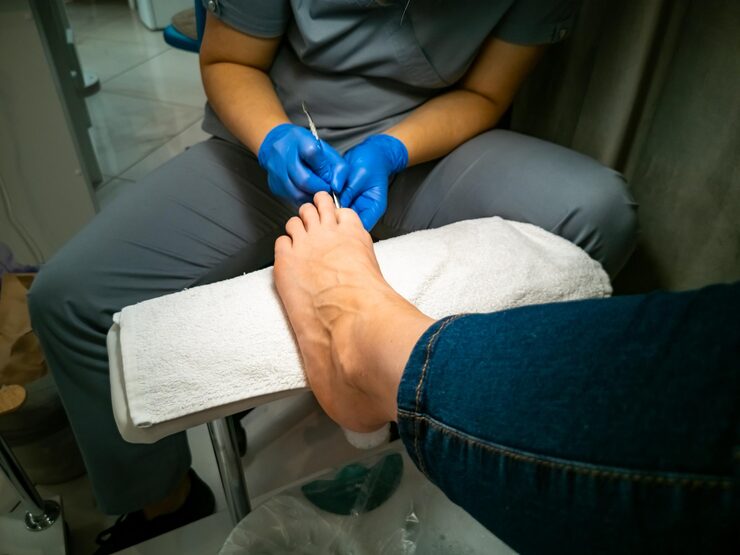Healing a wound on the foot takes far more than a simple bandage. Behind the scenes, a foot wound care specialist uses advanced treatments that many patients never realize exist. These services go deeper than surface-level care, focusing on restoring mobility, preventing complications, and protecting overall health.
Wound Debridement (Removal of Dead or Infected Tissue)
Dead or infected tissue can stop a wound from healing. That is why wound debridement often becomes the first step a foot wound care doctors recommend. By removing damaged tissue, healthy skin underneath is given the chance to repair itself. Debridement also reduces bacteria, lowers the risk of infection, and sets the stage for advanced therapies to work effectively.
A foot wound care specialist may use a variety of methods to perform debridement, from surgical tools to chemical agents. The choice depends on the wound’s size, depth, and severity. Without this important step, wounds can stall or worsen, leaving patients at risk of long-term problems. Many people are surprised that removing unhealthy tissue is actually one of the most important parts of wound recovery.
Off-loading via Custom Footwear, Braces, or Padding to Relieve Pressure
Constant pressure is one of the main reasons wounds on the foot fail to close. Off-loading is a technique that redirects weight away from the injured area, giving skin the chance to repair. This might involve special shoes, braces, or soft padding designed to keep pressure off vulnerable spots.
A foot wound care doctor often works with patients to find the right balance between comfort and support. Off-loading is not just about footwear; it also involves teaching patients how to walk or stand differently to protect the healing area. Without pressure relief, even the best bandages or medications may not help. This strategy plays a major role in preventing recurring wounds and keeping patients active.
Infection Control Through Antibiotics and Topical Antimicrobial Treatments
Infections can spread quickly in foot wounds, especially in patients with diabetes or circulation problems. That is why infection control is a priority for any foot wound care specialist. Oral antibiotics may be prescribed, but topical antimicrobial ointments and dressings are often used as well. These treatments directly target harmful bacteria while keeping the wound moist and clean.
In addition to medication, regular wound cleaning helps reduce infection risk. A foot wound care doctor carefully monitors signs like swelling, drainage, or foul odor. Early action prevents complications that could otherwise lead to hospitalization or even surgery. Infection control is more than treating what already exists—it is about stopping new infections before they begin.
Diabetic Foot Ulcer Management
Diabetic foot ulcers are among the most serious conditions a foot wound care specialist treats. High blood sugar levels slow the body’s ability to heal, and poor circulation makes the problem worse. These ulcers often begin as small sores but can quickly develop into deep wounds if ignored.
A foot wound care doctor focuses on multiple strategies at once: controlling blood sugar, relieving pressure, preventing infection, and supporting tissue growth. Advanced dressings, wound debridement, and even skin substitutes may be used. Because diabetic ulcers carry such a high risk of complications, consistent care is essential. Patients benefit greatly from early treatment before the ulcer progresses to a stage requiring surgery or amputation.
Patient Education on At-home Care & Prevention
Education is one of the most valuable services offered by a foot wound care specialist. Patients learn how to care for wounds at home, how to clean them properly, and how to recognize warning signs of infection. Simple daily habits, like checking feet for blisters or keeping skin moisturized, often make the biggest difference in long-term outcomes.
A foot wound care doctor also teaches prevention strategies, especially for those at high risk such as diabetic patients. Choosing the right socks, shoes, and foot hygiene practices can help prevent wounds from forming in the first place. This education empowers patients to play an active role in their recovery and reduces the chances of future injuries.
Regular Monitoring and Early Intervention for Wounds Slow to Heal
Even small wounds can become dangerous if they do not heal on schedule. Regular monitoring allows a foot wound care specialist to catch slow-healing problems early. By tracking progress week by week, the doctor can adjust treatments, add therapies, or refer to other specialists if necessary.
This ongoing care prevents complications from becoming severe. For example, a wound that looks stable but has not improved in several weeks may signal circulation problems or infection beneath the surface. A foot wound care doctor often orders additional tests to uncover these hidden issues. Early intervention ensures patients do not wait until it is too late to save tissue or mobility.
Addressing Pressure Sores & Traumatic Wounds (Cuts, Abrasions Etc.)
Pressure sores, cuts, and abrasions on the foot are often underestimated. These wounds can appear harmless but may worsen quickly if untreated. A foot wound care specialist addresses these injuries with protective dressings, pain relief, and therapies designed to accelerate recovery.
For patients with limited mobility, pressure sores are especially concerning. A foot wound care doctor may recommend cushions, padding, or position changes to prevent sores from getting worse. Traumatic wounds like deep cuts or abrasions may require stitching, advanced dressings, or additional treatments to avoid infection. What looks like a simple scrape on the surface may actually need careful professional management to heal safely

